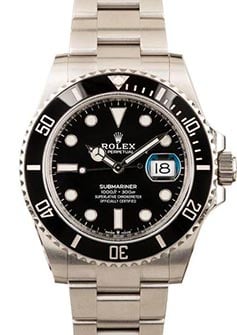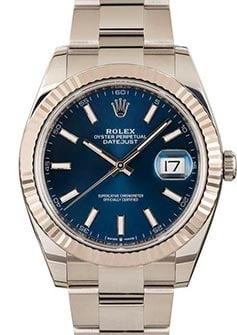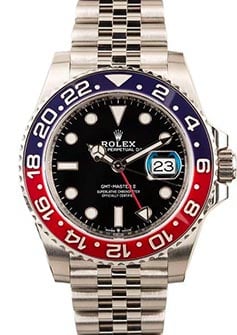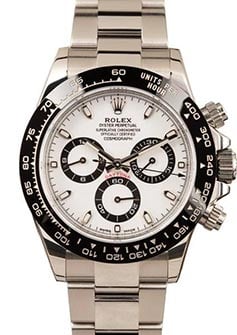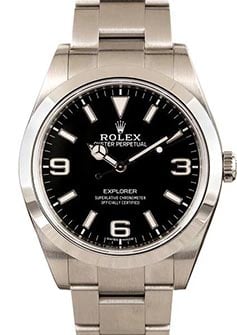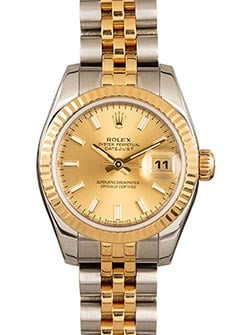Rolex Models
Rolex Models
If you're looking to get top dollar for your watch be sure to visit our Sell Rolex page or simply fill out the form below to get started.
Shop Rolex Watches
Explore
Popular Models
Rolex Model Numbers
Find your Rolex model number by browsing the list below. To quickly find your reference number, use Ctrl-F on your browser to search for a specific model number. These numbers can also be found on the certificate that was issued with the watch by Rolex, or between the lugs at the 12' position.
Air-King
The Air-King is considered by many to be the most affordable member of the Rolex family of watches and is known for its simplicity and balanced styling. The current models come standard with an Oyster bracelet, no date, and are 34mm in diameter. The reference model #114200 sells retail at about $5,000 while the #114234 has a white gold bezel and has a retail price of about $6,200. Some folks like searching Rolex models by year, or "new Rolex model numbers", or even "Rolex Submariner models". Specifically designed for British Royal Air Force (RAF) pilots in the 1930s, the Air-King’s simplicity and large watch faces (32 to 34mm in diameter) were not ordinary in watch design for the time—but Rolex founder Hans Wilsdorf felt large dials were essential for night flying. Given names like the Air Tiger, Air Lion and Air Giant, only the Air-King model remains today, however, many seek out the older models based on their airmen history. Original Air-King models were hand-wound and built with the classic 10.5 ligne hunter movement until they were upgraded to the more popular Oyster Perpetual (automatic) movement. We do not provide "Rolex models by year". Available in both gold and steel combinations, the Air-King is known in Rolex fan forums as “the watch rich in history” or the “Warrior Watch.” Rolex Air-Kings place in the entry-level category of Rolex watches as far as price, yet these models are still stunning with chronographs, 31 jewel movements and scratch resistant sapphire crystals. Simplicity and durability make the Air-King popular and functional and the waterproof cases endure in water and outdoor sporting. The most popular and sought after models include the 114200, 14010 and the 5500. To view more current Rolex models, visit www.rolex.com.
Cellini
Named for the 16th century Italian goldsmith Benvenuto Cellini who provided his services to popes and kings, this fine collection of Rolex watches comes in a variety of designs and styles. Each is encased in 18K yellow gold with either quartz or manual wind movement, white or mother of pearl dial, either Arabic or Roman numerals and 18K gold bracelet or leather strap.
Date
Similar to the Air-King the Rolex Date debuted in the 1950s and included a date function and employed 34mm diameter faces. Today's Date watches are available in steel only and feature an innovative design with automatic chronometer movement and a waterproof case safe up to 1000 meters. The original model line of Date watches were available in steel, 18 carat yellow and steel and 18 carat yellow gold all with fluted bezels and diamond markers making them sought after by Rolex collectors and investors. Favored models include the 1501, 15200 and the 15053.
Datejust
This Rolex model was first offered in 1945 and remains the best-selling Rolex watch today most likely for the many available variations. The following "Rolex models", are listing below and some are considered to be "old Rolex models" numbers. Along with the many different steel cases and bracelet selections, the DateJust is available in steel and yellow gold, steel and rose gold and solid gold. DateJust enthusiasts can choose from a variety of dials and diamond bezel choices. First designed with a Jubilee bracelet, today's DateJust Rolex watches come with Oyster bands. Rare DateJust models include those with smooth bezels—most are fluted. Because of the many designs available, the DateJust is the go-to Rolex for everything from golf to the office. Additional features of the DateJust include auto winding technology Cyclops date, waterproof case and ultra-smooth 31 jewel movement. Dials sizes range from 26mm to 41mm. Popular models include the 116138, 116200 and the 116234.
Datejust Mid-Size
This popular line is similar to the Datejust, except that the case is 31mm, instead of 36mm. It also is distinguished by its handsomely designed dial with Roman numerals and gold time markers, and it comes in 18K gold and stainless steel or stainless steel. Other features include self-winding technology, date window, 29-jewel movement and fluted bezel. This Datejust Mid-Size can be a men's or women's watch.
Datejust Oysterquartz
For a quarter-century, Rolex produced the Oysterquartz in Datejust, models 17000 (stainless steel) 17013 (steel/Yellow Gold) and 17104 (steel/White Gold). Special models of the Oysterquartz were made with jeweled dials, bezels and bracelets. Fewer than 25,000 Oysterquartz watches are believed to have been made. The last time one appeared in a Rolex catalog was 2001. It also is the last year that Rolex received chronometer certificates for the quartz movement from the COSC. The steel gold and all gold models continued to appear in the Rolex catalog until 2003, when the last of the models in stock shipped.
Datejust Turn-O-Graph (Thunderbird)
Launched in 1953, the Turn-O-Graph was designed for adventure lovers. It was discontinued in the early 1960s, then reborn as a special version of the Datejust. The modern Turn-O-Graph features a bi-directional bezel to measure elapsed time, making it the most functional and expensive watch in the Datejust line. Prior to the introduction of the Day-Date President, it was the most expensive Rolex cataloged.
Day-Date (Presidential)
The Rolex Presidential was nicknamed the "President", or "Presidential", after the company presented one to then-president Dwight D. Eisenhower in the 1950s. It features a calendar mechanism that displays the date and day using the self-winding Oyster movement. It comes in Day-Date I (36mm case) and Day-Date II (42mm case) models.
Day-Date Oysterquartz
Similar to the Datejust Oyster quartz, the Day Date Oyster quartz was launched by Rolex in 1977 in two different model variations. One model was the 19018 which came in yellow gold and the other model was the 19019 which came in white gold. Both models featured fluted bezels, sapphire crystals, and integral bracelets. The last year these watches were produced by Rolex was in 2001, again the same as when the Datejust Oyster quartz was discontinued. These watches were in production for only 24 years and are now discontinued making them even that much more rare now!
Daytona (Cosmograph)
From the 1960s to the 1980s, Rolex produced the Daytona / Cosmograph in two variations, however, the demand for the first (a Valjoux workhorse) brought forth the second, which came with a Zenith modified movement. Named for the famous race and speedway, perhaps the turning point for its popularity came when actor Paul Newman was seen wearing his Daytona Rolex at racing events. This model is available in stainless steel, 18 carat gold and stainless steel and 18 carat solid gold. By 2000, Rolex released a Daytona with a caliber 4130 which came with a 72 hour power reserve (model 116520). Surprisingly, the two-tone and gold variations are not the big sellers in the Daytona line up so for function and fashion with a little Newman thrown in, go for the stainless steel.
Explorer
Rolex first introduced the Explorer in 1954 and this model has remained steady in its features including a black dial with Arabic numbers, no date function and a smooth bezel. The 36mm stainless steel case in model 14270 was updated in in 2010 to the 39mm 214270 model. The idea behind the Explorer was its ability to withstand temperatures between -20C and +40C and historians tout the Explorer was made in honor of Edmund Hilary and Tenzing Norgay—the first men to reach the summit of Mt. Everest. Original models (6350 and 6150) came with bubble back 10.5 movement and a certified chronometer. With the 14270 model, the Explorer featured a new case, dial, movement and glass and finally a sapphire crystal glass. Because of the wide variations in design, collectors now seek out modern-day models such as the 214270 which come with a waterproof case, 24-hour rotating bezel, luminous 24-hour markers, and a black and sapphire dial.
Explorer II
Much like the Explorer, the Rolex Explorer II had exploration in mind. It was equipped with a fourth hand that rotated once every 24 hours and designed for speleologists (cave explorers) who often had trouble differentiating between the morning and afternoon or day and night. Although the Explorer II was released in the 1970s, it didn't become popular until the early 1990s. Early models, the 1655 and the 1019 were the only two watches that utilized hands not used by any other Rolex model. By the early 1990s, the 1655 model came with sapphire glass and also allowed the owner to set the hour hand backwards or forward in one hour jumps. The 16570 models are the most popular today and feature 31 jewel movement; auto wind technology, Rolex Quickset, scratch resistance sapphire crystal, a waterproof stainless steel case and black dial with luminous time markers. Because of the many model changes and although the idea of durability of the Explorer II has never changed, model prices vary based on the release date, degree of rarity and feature set.
GMT-Master I & II
From the 1950s to the 1970s, Rolex and their GMT-Master and GMT Master II timepieces were something to be seen and owned. The GMT-Master boasted a variety of dial colors and bracelet types making it the Rolex for the fashion and function. Great in depths up to 30 meters, the GMT-Masters model line also featured 31 jewel movement, waterproof case and Rolex Quickset. These watches were popular based on their ability to use a second hour hand to indicate a second time zone in the original model and by the 1970s, the GMT-Master II allowed for easy adjustment of a second hour hand with the crown in position two. There are all-black dial steel models and other models come with black, red/black or red/blue dials—the most popular bracelet is the Jubilee for all GMT-Master Rolex watches. Hot today is the GMT-Master II model 116710 with a maxi-case, 3186 caliber movement and ceramic bezel. Because GMT-Master Rolex watches increase in value, they are very collectible.
GMT-Master I
GMT-Master II
Ladies Date
Introduced in the late 1970s, the GMT-Master II like its predecessor 20 years earlier, utilizes a second hour hand to indicate a second time zone. It comes with a simple rotating 24-hour bezel so it is easy to tell the time in any time zone. It also allows the user to easily adjust the second hour hand with the crown in position 2. The steel models are only offered with black dials. The bezels are available in black, red/black and red/blue. GMTIIs typically come with a Jubilee bracelet.
Ladies Datejust
The Lady-Datejust offers opulent choices of bracelet bands and bezels of yellow gold, white gold, platinum or dazzling dual tone. Each watch includes a 32-jewel precision (real diamonds, rubies, emeralds and sapphires) movement and faces bedazzled in a constellation of genuine diamonds. Each piece is painstakingly crafted with the best of materials for a watch that will last for years to come. The automatic movement keeps accurate time, date and second hand movement. The buyer also has different choices in face color (such as sapphire blue and salmon) and number font.
Ladies Oyster Perpetual
The Rolex Oyster Perpetual Datejust Ladies Watch features an automatic Swiss movement. The dial features date magnified at three o'clock position. The 18K Yellow Gold Case is attached on an 18K Yellow Gold bracelet which securely locks with a fold over hidden closure and Rolex logo. It has a 26mm case and automatic movement.
Masterpiece
Rolex Masterpiece watches come in different colors but the standard colors are blue, white and silver. The most important feature of the Rolex Masterpiece watches is its dial styles that are Index, Roman or Arabic. The Rolex Masterpiece watch also boasts automatic winding movements. Generally, these watches are made up of stainless steel and gold or polished with diamond, mother of pearl, ruby and precious gems.
Milgauss
Scientific accuracy was the ideology behind the Milgauss Rolex watch. This scientific need most likely came from its release in 1956 to scientists working near high levels of magnetic energy which made their watches lose precision. The Milgauss 116400 features a waterproof 40mm stainless steel case with a smooth bezel and black dial and stunning white and orange luminous hour markers. In 2008 Rolex released a Milgauss Green Crystal anniversary edition, the 116400 GV which can withstand magnetic fields up to 1,000 gauss. While variations over the years vary little, the Milgauss remains supreme and a favorite of those in the science field or the up and coming for its function and durability.
Oyster Perpetual
Similar to the Air-King 34mm model, the Oyster Perpetual (No Date) perplexed many as all Rolex timepieces are also Oyster Perpetual. The energy and popularity behind this model comes from the varied dial options, however, today’s Oyster Perpetual (No Date) Rolex watches are available in steel or steel with a white gold bezel. Popular sizes range from the 26mm ladies to the 34mm—there is also a 31mm mid-size version of the Oyster Perpetual.
Sea-Dweller
For deep sea divers, the Sea Dweller Rolex watch was introduced in 1978 and sadly, discontinued in 2008. Part of the reason to discontinue this Rolex model was perhaps its similarity to the Submariner except the steel case was heavier and it came with a durable crystal with no Cyclops eye. A helium escape valve was only useful for deep sea divers and Rolex actually named one model, the Rolex Submariner 2000 Sea Dweller, but later dropped the Submariner 2000 from its name in 1973. The 16660 Sea Dwellers remain a diver favorite and include auto winding technology, 31 jewel movement, rugged stainless steel case and of course the desired helium escape valve. The face is oversized for easy viewing in underwater conditions and its stainless steel Oyster bracelet with secure flip-lock clasp makes it possible for this Rolex watch to withstand depths of 4000 feet or 1220 meters. The discontinuation of the Sea Dweller makes it quite collectible and rare.
Submariner
Production began on the Rolex Submariner in 1954 and this model is only available with an Oyster bracelet with a 40mm case. Perhaps the most recognizable Rolex today based on its black dial, over the years Rolex has released many anniversary editions—some even with green bezels. The single direction rotating diving bezel is part of its essences and many consider the Submariner to be the "James Bond" Rolex watch. The late 1970s and late 1980s models offered the Rolex Quickset function and sapphire crystals in models 16800 and 16610, respectively. By 2010, model 116610 came with a ceramic bezel and locking buckle. Variations of the Submariner include the steel (no date), steel (with date) and yellow and white gold. An 18 carat gold and steel model is also available and if diamonds delight you, they are only available in the gold models. The Submariner may forever be known as the “ever-changing” Rolex watch with the vast array of available models.
Submariner Date
Launched in 1953, the Submariner was the first Rolex guaranteed waterproof to a depth of 200 meters (660 feet). The Oyster Perpetual kept time for the likes of Sir Edmund Hillary and Tenzing Norgay on their successful quest to the top of Mount Everest that same year. Since then, these watches have become known as the watches of achievers. The Submariner comes only on an Oyster bracelet and has a 40mm case. The steel model is only available with a black dial, and is one of the most recognizable Rolexes. Anniversary editions with green bezels can occasionally be found. The Submariner has the common single direction rotating diving bezel with minute markers for the first 15 minutes. The original models—those made until 1956—are often considered "James Bond" models and have some easily recognizable differences. Notably, they have a smaller crown, no crown guard, and the bezel only had minute markers every five minutes. In 1982, the model 16800 was introduced. It sported the new sapphire crystal and quickset function. In 1989, the 16610 was introduced with an improved movement and a more secure bezel. The 116610 was introduced in 2010 with a ceramic (Cerachrom) bezel and improved Glidelock buckle. The Submariner is one the most popular models and comes in a variety of styles.
Yacht-Master
In 1992, Rolex released the Yacht-Master in both men and women’s styles and popular models include the 16622, 168622, 16623 and the 68623. Dials are available in full or mid-size and the Yacht-Master is available in stainless steel and gold and perhaps the most desired—platinum! The first model used the caliber 3135 movement much like the Submariner and Sea-Dweller and Rolex Yacht-Master watches are fitted with a triplock crown. Not made for watersports (resistant only to 100 meters), these watches shout flair and fashion. The 40mm version is often referred to as the Jumbo Yacht-Master. A favorite among celebrities, the Yacht-Master, a relatively new watch to the Rolex line up continues to grow up and get noticed.
